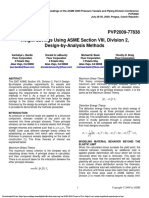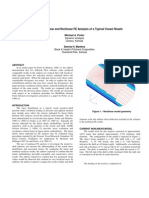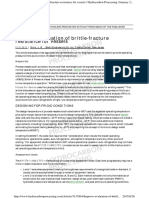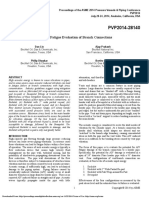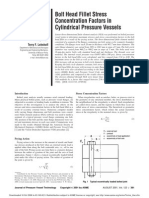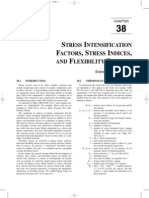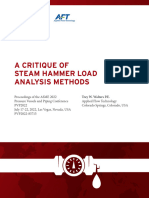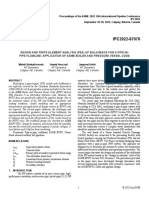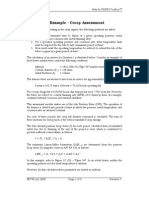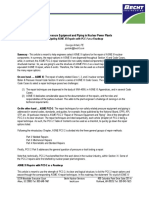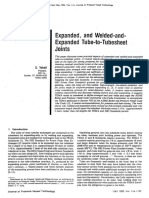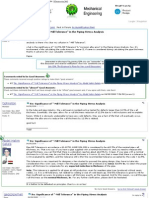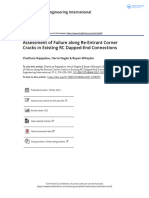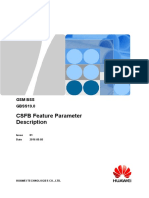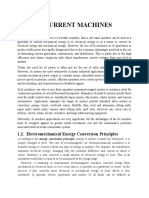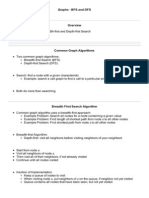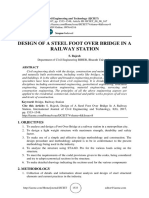Common Misunderstandings About Gasket and Bolted Connection Interactions
Common Misunderstandings About Gasket and Bolted Connection Interactions
Uploaded by
Juan KirozCopyright:
Available Formats
Common Misunderstandings About Gasket and Bolted Connection Interactions
Common Misunderstandings About Gasket and Bolted Connection Interactions
Uploaded by
Juan KirozOriginal Title
Copyright
Available Formats
Share this document
Did you find this document useful?
Is this content inappropriate?
Copyright:
Available Formats
Common Misunderstandings About Gasket and Bolted Connection Interactions
Common Misunderstandings About Gasket and Bolted Connection Interactions
Uploaded by
Juan KirozCopyright:
Available Formats
Proceedings of the ASME 2012 Pressure Vessels & Piping Conference
PVP2012
July 15-19, 2012, Toronto, Ontario, CANADA
PVP2012-78702
Common Misunderstandings About Gasket And Bolted Connection Interactions
David Reeves Dr. Warren Brown
Chevron Corporation Integrity Engineering Solutions
Chevron Richmond Refinery Tech Center Dunsborough, Western Australia
Richmond, CA, USA wbrown@integrityes.com
ABSTRACT Take the test below and see how your assumptions
Unfortunately most people’s knowledge about bolted compare to the answers that follow.
connections comes more from information that has been “passed Question 1: True or False: Most graphite faced gaskets
down” from a variety of sources than a solid understanding of will relax in the first week and become stable.
the physics and science that impacts pressure boundary bolted Question 2: True or False: Setting studs stresses in
connection reliability. A correct understand of bolt and gasket stages (30%-60%-100%) is important to the long term reliability
interactions gives a person the skills to reliably solve a variety of of the gasket and connection.
sealing application problems. This paper looks at some of the Question 3: True or False: Use of a star pattern is
more significant misunderstandings that inhibit people’s ability essential to setting accurate stud stresses on heat exchangers.
to effective resolve and prevent problems with bolted Question 4: True or False: Once exchanger body flange
connections. stud stresses are set correctly to their final stress, no further
adjustment is needed. This question assumes standard B7 stud
INTRODUCTION material with 2 nuts in an ASME Section 8, Division 1 designed
To a lot of field mechanics and engineers, bolted flange.
connection reliability is more of an art than a science. Last year Question 5: True or False: Setting stud stresses as a
a presentation was made to most the major gasket manufactures. single percent of yield strength for heat exchanger and pipe
It started by asking three questions: flanges is a good way to get consistent connection reliability.
1. How many of you publish recommended stud Question 6: True or False: During a pressure test,
stresses for pipe flanges? assuming the stud stress is above the minimum needed to keep
2. How many of you publish recommended gasket the gasket seated, stud stresses will increase due to the added
stresses? hydraulic end force.
3. How many of you publish gasket relaxation rates? Question 7: True or False: During a pressure test,
assuming the stud stress is above the minimum needed to keep
No one offered any answers. the gasket seated, stud stresses stay the same because the
hydraulic end force is not enough to overcome the pre-load in
This has really been the problem: Without a simple set
the studs.
of specification to design to, trying to get reliable bolted
Question 8: True or False: Retightening a connection
connections is like trying to build a house without a soils report,
reduces the life of the gasket and reliability of the connection.
any idea as to how much load a wall can support, or the load
Question 9: True or False: If gaskets are completely
carrying ability of the ceiling joists. To make matters worse,
unloaded, they will likely not seal reliably after being
there is a rather impressive list of “logical assumptions” that
retightened.
most people hold about pressure boundary bolted connections
Question 10: True or False: As long as studs are well
which are really common misunderstandings. When a bolted
cleaned with a wire brush and re-lubricated, they can be reused
connection fails to perform as anticipated, it is as important to
to set accurate stud stresses.
know what to rule out, as it is what to focus on in trying to
Question 11: True or False: Spiral Wound pipe flange
determine the root cause of the problem. Common
gasket widths change by flange size and class to adjust for
misunderstandings inhibit a person’s ability properly identify the
differences in pressure rating and variations in the number and
root cause of the problem.
size of studs.
Question 12: True or False: Papers presented at the
ASME-PVP conferences are regularly reviewed by code
24 Questions
members for possible inclusion in further code updates.
1 Copyright © 2012 by ASME
Downloaded From: http://proceedings.asmedigitalcollection.asme.org/ on 02/18/2016 Terms of Use: http://www.asme.org/about-asme/terms-of-use
Question 13: True or False: Code equations are used to
size the flange given its size, design pressure, design temperature
and material of construction. The code also uses “m” & “y”
values in the design of pressure vessel bolted joints. These are
pretty accurate representations the gasket stress needed to
establish a seal (the “y” number) and maintain a tight seal after
the vessel has been pressurized (The “m” or Maintenance
factor). These numbers are based on a standardize test that
yields very reproducible results.
Question 14: True or False: When new gasket designs
become available and are being used by end-users, they are
added to the pressure vessel code.
Question 15: True or False: Pipe flange gaskets built to
B16.20 (Spiral Wound gasket specification) will provide a
reliable and tight seal.
Question 16: True or False: TEMA calls for the use of
double jacketed (also called DJ or Clad gaskets) in the design of
heat exchangers because this gasket has a long history of
FIGURE 1: Graphite Faced Gasket Relaxation
providing reliable leak free performance if installed correctly.
Question 17: True or False: For years, air operated
It might be noted that Figure 1shows an average stud
impact guns and hand wrenches have been used to set stud
stress that is above the 105,000 psi minimum code yield strength
stresses. These tools provide an accurate enough way to set stud
for B7 material. Testing has shown that some studs can handle
stress so the gasket will perform as designed without damage to
up to 120,000 before yielding, which in most cases just causes
the bolted connection as long as they are used by a trained
elongation of the stud material. These high loads are only
operator.
present for a short time before relaxation in the connection drops
Question 18: True or False: Given that Teflon is a
the stud stress back down. While flanges need to be evaluated
lubricant, Teflon coated studs do not need to be lubricated.
on a case by case basis, additional analysis has shown that
Question 19: True or False: Ring Joint flanges (RTJ or
ASME Section 8, Division 1flanges design with a 4 to 1 safety
ORJ) provide one of the most reliable seals because metal to
factor can handle high stud stresses without significant yielding
metal seals do not suffer from gasket relaxation and other
that would impact sealing performance or require repair.
problems associated with semi-metallic and soft gasket
Answer 2: False. While flanges need to be loaded so
materials.
they remain parallel, there is no technical support that shows
Question 20: True or False: Feedback from gasket sales
increasing gasket stresses in stages has any impact on bolted
people and end users is a very good way to judge a gaskets likely
connection reliability. Figure 2 is the tightening pattern used in
performance in your facility.
many refineries and in a Japanese High Pressure Institute
Question 21: True or False: Most bolted connections
standard, where 4 studs are tightened to 100%, than the stud
designed by the code have about the same amount of built in
stresses are set to 100% in a circular pattern.
spring, so even connections where the ratio of stud length to
diameter is 5 or less, these connections will perform about the
same as other connections where the ratio is higher.
Question 22: True or False: Once a heat exchanger is on
line, stud stresses remain stable even while the plant is being
shut down.
Question 23: True or False: When a bolted connection
starts to leak on line after it has passed the initial hydro test, it is
very hard to tell exactly why the connection is leaking.
Question 24: True or False: The oxidation rate of the
graphite from one Spiral Wound gasket to the next is about the
same.
24 Answers
If you answered all 24 as false, give yourself a hand and
stop reading! If not, read the answers to the questions you
marked as true.
Answer 1: False. Graphite faced gaskets take about 15
months before stud stresses approach what might be called
stable. Roughly, for the average code designed exchanger FIGURE 2: Tightening Pattern
flange, for every .001 inches (0.0254 mm) of graphite that flows Answer 3: False. Unless the flange is warped, as long
out of the connection, about 8,000 psi stud stress will be lost. as at least four studs in each quadrant are snug tightened
For bolted connections that are stiffer, the stud stress loss can be initially, there is no fulcrum to transfer the stud stress from one
much higher. The Figure 1 shows a graphite covered, side of the flange to the other side, so whatever stud stresses are
corrugated metal gasket relaxation over 22 months. set on one side of the flange have just about zero impact on stud
2 Copyright © 2012 by ASME
Downloaded From: http://proceedings.asmedigitalcollection.asme.org/ on 02/18/2016 Terms of Use: http://www.asme.org/about-asme/terms-of-use
stresses on the other side of the flange. Consider Figure 3 where including cost, cracking of the spring material, the number of
all the studs on this floating head were tightened to 60,000 psi, spring washers that would be required, the rating limitations of
then studs were removed one at a time starting at the bottom. the washers and the complex spring arrangements that might be
Note the three load cells at the top of the flange. Figure 4 shows needed.
how these load cells react as studs are removed. Until the third
stud on either side of the load cell is removed, the stud stress
under the load cell remained pretty constant.
FIGURE 5: Stud Load Changes Due to Gasket Relaxation
FIGURE 3: Floating Head with Load Cells
For graphite faced gaskets, roughly for every .001 inch
of reduction in gasket thickness, 8,000 psi stud stress will be
lost. Given that corrugated metal gaskets will relax about 35%
and Kamprofile gaskets will relax 20% to 25%, experience has
shown that unless heat exchangers are hot torqued when the
flanges first reach 250F, leaks tend to appear 12 to 18 months
after assembly.
Answer 5: False. Gaskets seal because the minimum
stress needed for them to contain the pressure is maintained.
While there is just about an infinite number of operating
pressure, gasket, stud size and number configurations, gaskets
seal at an optimum gasket stress under operating pressure
regardless of these variables. That is why stud stresses have to
be set on each bolted connection to optimize the gasket stress,
and not as a percentage of the studs yield strength. As an
example, Figure 6 shows the gasket stresses that would result if
all NPS 24 inch or below pipe flanges were assembled to a bolt
stress of 50,000 psi.
FIGURE 4: Load Cell Stud Stress Changes
Answer 4: False. All gaskets relax. Unless you know
how much the gasket will relax, the minimum stress needed for
the gasket to keep the connection tight, and the starting gasket
stress, it is not possible to say if the connection will need to be
retightened or not. Figure 5 shows the relaxation percentage for
two graphite covered gaskets, one covered with .030 inch think
graphite (0.762 mm), and one with .020 inch thick graphite
(0.508 mm). Note that as soon as the exchanger starts to heat
up, the gasket starts to relax and the stud stress drops. The end
user has to decide if they can tolerate this level of relaxation
over life of the connection, of if the connection needs to be
retightened.
Some end users have considered using spring washers
to try and offset this relaxation, but there are down sides to this, FIGURE 6: Pipe Flange Gasket Stresses at 50ksi Stud Stress
3 Copyright © 2012 by ASME
Downloaded From: http://proceedings.asmedigitalcollection.asme.org/ on 02/18/2016 Terms of Use: http://www.asme.org/about-asme/terms-of-use
Gasket performance does not decline by unloading and
Answer 6 and 7: False. A lot of people think the stud reloading. It declines from the inability to tolerate radial shear
stresses go up when the connection is exposed to the hydraulic between the flanges, damage to the gasket or the inability to
end force. If this were true, the gasket would become unloaded conform to a slightly different sealing surface if it is disturbed.
and the connection would leak. Others understand that until the Answer 10: False. If the stud temperature is below
pre-load in the stud is overcome by the hydraulic end force, the what is required to burn off the anti-seize, the threads will
stud stresses will not change. What most people miss is that the become polished while it is being loaded, which will slightly
pressure is also blowing up the pressure vessel like a balloon, drop the K factor. If the anti-seize burns off, over an extended
building pressure on the shell. As the shell expands, the flange run cycle, corrosion, solids from the anti-seize, scale and a minor
rolls slightly and the stud stress drops, as can be seen in Figure amount of metal transfer between the threads takes place. Wire
7. So, depending on the different stiffness of each of the brushing is not adequate to remove these latents. Figure 9 shows
components, the stud stress may increase or decrease once the distribution in stud stress using new studs and a torque
pressure is applied (but the gasket stress always decreases). wrench, Figure 10 shows the distribution in stud stress using
wire brushed and well lubricated used studs.
FIGURE 7: Stud Stress Reduction During Hydrotest
Answer 8 and 9: False. Unloading and reloading a
gasket has no more impact than taking your weight on and off FIGURE 9: Stud Stress Distribution, Torquing New Studs
your shoe. Both are constructed to handle the loads that are
likely to be applied. We have dropped heat exchanger channel
sections, not replaced the gasket between the tubesheet and shell,
and as long as the gasket is not disturbed, returned the exchanger
back to leak free operation. By not disturbing the gasket, the
facing material stays intact and re-seats at the same location.
This point is also supported by Figure 8 [1]. Here the
leakage was measured on a Spiral Wound gasket after initial
installation (left side), and after it was reinstalled (right side).
While we are not attempting to suggest that SW gasket can be
reused, this result is consistent with field experience that
unloading and reloading gaskets does not impact their ability to
seal.
FIGURE 10: Stud Stress Distribution, Torquing Used Studs
Answer 11: False. See answer to number 5 above and
Figure 6. Figure 11 shows that the winding width increases in
an orderly fashion as the pipe flange size and class increases. If
using a gasket that looks to have an orderly design basis gives
you confidence that the gasket was properly designed and will
provide a tight seal, then you should be really happy. However
if you are looking for a consistent gasket stress at the flange’s
FIGURE 8: SW Gasket Sealability after Reinstallation maximum rated pressure, stud stresses have to vary
4 Copyright © 2012 by ASME
Downloaded From: http://proceedings.asmedigitalcollection.asme.org/ on 02/18/2016 Terms of Use: http://www.asme.org/about-asme/terms-of-use
considerably, per Figure 12, to overcome the significant that is “fast-tracked”). Papers are important for generating ideas,
variations in number and size of studs used in each flange [5]. In sharing information and for the consideration of new
addition, the present winding and ring widths can often result in approaches, but the information needs a passionate champion to
either the inner ring buckling (even though B16.20 was recently move forward.
revised to address this issue) or the outer ring slipping off the Answer 13: False. While the Fluid Sealing Association is
raised face. Insufficient inner ring width and insufficient raised working on one, for years there has not been a standardized and
face overlap can have serious joint integrity consequences. repeatable test to establish M&Y numbers.
Answer 14: False. Changes to the code, even for new
gasket designs, come very slowly. In 1995 a major oil company
discovered that certain graphite covered gasket designs, if
installed correctly, could eliminate exchanger leaks. Even
though this gasket design is used exclusively in 95% of over
15,000 exchangers, and has been included in hundreds of
presentation all over the world including a 2001 ASME-PVP
paper [2], it is still not referenced as an option in the pressure
vessel code. A check of a current copy of the pressure vessel
code will also show that “m” & “y” numbers have not been
published for any graphite faced gaskets. In terms of joint
integrity, this may be good thing, as “m” & “y” numbers for
graphite faced gaskets will be lower than for the double jacketed
gaskets that most exchanger designs are based on. The lower
“m” & “y” values, under present design rules, will result in
thinner flanges with fewer studs. From a sealing perspective,
exchanger body flanges should be designed such that they will
not yield if all the studs are tightened to their yield value. This is
FIGURE 11: Spiral Wound Winding Radial Widths
the only way to design flanges to ensure they cannot be yielded
by an overly aggressive mechanic trying to stop a leak.
Answer 15: False. See last year’s PVP paper [1] on SW
winding density for the complete story. B16.20 currently
requires that the winding has to crush to 0.130 inches (3.3 mm)
by the time studs reach a 30,000 psi stud stress. This creates a
very soft winding where the flanges end up sealing on the outer
guide ring. Figure 13 shows gasket stresses at a 30,000 psi stud
stress at the maximum pressure rating of the flange. Note that
the manufacturers minimum recommended gasket stress of
10,000 psi is not met for most 150 class flange sizes, most of the
300 class flanges above 4 inch, and a few sizes in the 600 class.
If we bump the minimum gasket stress to 12,500 psi, which is a
more typical minimum seating stress, none of the 150, 300 and
600 class flanges above 4 inch would meet the minimum.
Figure 14 shows methane leakage in PPM for a standard
spiral wound gasket. In order to assess if the windings or the
guide ring was providing the seal, a groove was placed in the
guide ring as shown in Fig. 15. Figure 16 shows the high leak
rate that resulted, indicated that the flange was not sealing on the
FIGURE 12: Stud Stresses Needed To Achieve a Consistent windings. Figure 17 shows methane leakage in PPM for a high
Spiral Wound Winding Gasket Stress density winding with a grooved guide ring.
Answer 12: False. While this may happen in some cases, in
the area of gaskets and bolting technology, the changes that get
added to the code are the ones championed by one of the
committee members. The reason is that the person pushing the
change has to have a solid understanding of what the change
entails and why it is important enough to be added, which means
they probably have had a significant role in the research to
support the change and the writing of the modified standard. It
takes someone with a lot of passion to drive the change through
the many years (5 to 20) that it will take to get added. You can’t
“drop” a good idea at the ASME-PVP conference in the form of
a paper and expect it to show up in the next edition of the code.
In fact, the lag between the inception of a good idea and
incorporation in the codes is typically greater than 10 years (and
5 Copyright © 2012 by ASME
Downloaded From: http://proceedings.asmedigitalcollection.asme.org/ on 02/18/2016 Terms of Use: http://www.asme.org/about-asme/terms-of-use
FIGURE 17: Methane PPM Leakage, Standard Spiral Wound
with Scratched Guide Ring
Answer 16: False. Data from a major refinery shows that
about 40% of clad gaskets can be expected to have some level of
FIGURE 13: Winding Stresses at 30,000 PSI Stud Stresses leakage over a 4 year run cycle. Clad gaskets cannot tolerate the
thermally driven differential expansion between mating flanges
as shown in Fig. 18. This causes the rolled edge of the clad
gasket to split, as shown in Fig, 19. [2] [4]
You may be wondering why TEMA has not updated their gasket
recommendations, especially since this problem was reported in
an ASME-PVP paper back in 2001 [2]. Additionally, a major
gasket manufacturer and a major heat exchanger manufacturer
have both reported that currently only about 10% of their
exchanger gasket orders are for Clad gaskets. While the authors
don’t have an answer, one of the technical reviewers of this
paper wrote: “The Code places the responsibility for specifying
FIGURE 14: Methane PPM Leakage, Standard Spiral Wound components such as gaskets on the user or his designated agent!
[See Par. U-2(a) of the Division 1 Code.] Please try to
emphasize that point!” The reviewer is completely correct: The
end user has to be smart enough to know the differences in
gasket materials and make the right selection, as gasket
suggestions published in TEMA or the Code may not provide
the required performance.
FIGURE 15: Grooved Guide Ring
FIGURE 18: Differential Movement Between Flanges
FIGURE 16: Methane PPM Leakage, Standard Spiral Wound
with Scratched Guide Ring
6 Copyright © 2012 by ASME
Downloaded From: http://proceedings.asmedigitalcollection.asme.org/ on 02/18/2016 Terms of Use: http://www.asme.org/about-asme/terms-of-use
FIGURE 19: Split Clad Gasket FIGURE 22: Stud Stresses After Using A Torque Wrench
Answer 17: False. Figure 20 shows that hand wrenches will Answer 18: False. The K Factor (resistance to turning)
under-load studs, where Fig. 21 shows air impacts will over-load climbs as the stud stress increases on Teflon coated studs, per
studs. If the end-user wants to make sure studs stresses reach Fig. 23. If anti-seize is applied to the threads, the K factor is
their targeted values, new studs, or studs that have not been much more consistent over the same range of stud stresses, as
exposed to high heat, should be torqued, per Fig. 22. can be seen in Fig. 24. In addition, the role of the Teflon coating
is often to provide corrosion protection, which it does by acting
as a moisture barrier. If it is damaged during assembly, then it is
less effective at protecting against corrosion. The use of anti-
seize helps to prevent such damage.
FIGURE 20: Stud Stresses After Using Hand Wrenches
FIGURE 23: K Factor Teflon Coated Studs
FIGURE 21: Stud Stresses After Using an Air Impact Gun
7 Copyright © 2012 by ASME
Downloaded From: http://proceedings.asmedigitalcollection.asme.org/ on 02/18/2016 Terms of Use: http://www.asme.org/about-asme/terms-of-use
uninsulated flanges. Fig. 26 shows the 10,000 psi stud stress
changes on a Coke drum with 1-3/4” studs and a full face gasket
with uninsulated flanges. Fig. 27 shows the drop in stud stress
as the process temperature drops. Insulating flanges can
increase the magnitude of stud stress changes as well as the
amount of differential expansion between mating flanges.
FIGURE 24: K Factor Teflon Coated Studs With Anti-Seize
Answer 19: False. The sealing surface has to be in excellent
shape, free of any damage, for a solid metal seal to be able to
reliably seal against it. Every time an RTJ or ORJ ring is
installed and loaded, a little damage is done to the groove, since
the sealing mechanism of these gaskets is by metal plasticity.
Oval rings cause the most damage due to high point loading on FIGURE 25: Stud Stress Changes, Steady State Operation
the gasket corners, which is why many end-users do not use
them. This damage is cumulative until a new gasket can no
longer adapt well enough to the surface to establish a seal, and
the connection leaks. Then there are the added problems of
people trying to reuse RTJ/ORJ spacers and blinds due to the
high cost and lead time to get replacements. These become
work hardened after the initial installation and will not adapt as
well to a new surface. One major refinery reports that the only
flanges they have problems with are RTJ’s following gasket
changes, or the attempted reuse of spacers and blinds.
Answer 20: False. Sales people are professionals at selling
things. They may or may not fully understand their product, the
end-user application, or how their product is likely to perform in
the application. If a gasket fails to perform as anticipated, it is
the end-user responsibility to deal with the unanticipated
consequences. In order to properly select a gasket that will meet
performance expectations, all the possible failure root causes
must be identified and addressed by the selected gasket. If there
FIGURE 26: Stud Stress Changes, Coke Drum FF Flange
is any doubt as to how the gasket might perform, testing which
matches the application conditions, as much as possible, should
be performed.
Answer 21: False. Every bolted connection has its own
spring constant. The primary contributor to the total amount of
spring is a combination of the spring in the flanges and the
amount of stretch in the stud. Generally if the ratio of stud
length to diameter is 5 or less, as measured from the center of
the nut to the center of the nut, the connection is unusually rigid,
meaning any gasket relaxation will cause a higher percentage of
stud load loss. This is why exchangers with threaded tubesheets
are difficult to keep tight. As another example, the stud on a
valve’s packing gland is typically only stretched about .002
inches (0.05 mm). It does not take a lot of consolidation in the 5
rings of packing before all the stud stress is lost.
Answer 22: False. Exchanger flanges heat and cool faster
than the studs. Every time a control valve makes a small
adjustment, flange temperatures change, causing the stud
stresses to change. This effect can be seen in Fig. 25, which
shows a reboiler operating under stead-state conditions with
8 Copyright © 2012 by ASME
Downloaded From: http://proceedings.asmedigitalcollection.asme.org/ on 02/18/2016 Terms of Use: http://www.asme.org/about-asme/terms-of-use
CONCLUSIONS
While most people assume that logic can be used to
understand bolted connection and gasket interactions, it is a little
more complex than that. At a minimum, logic can lead to the
wrong answer, and the inability to put interactions into
perspective so they can be compared against each other to
understand the root cause of a leak. As an example, is it the
stiffness of a connection, the degradation of the gasket or sealing
surfaces, under-loaded studs, the stud stress loss from relaxation
or the process temperature change that is the cause of the leak, or
some combination of these?
REFERENCES
[1] ASME PVP2011-57556 – J Veiga, C. Cipolatti, N.
Kavangh, D. Reeves, The Influence of Winding Density in
FIGURE 27: Stud Stress Changes, Coke Drum FF Flange the Sealing Behavior of Spiral Wound Gaskets
[2] ASME- PVP 2001, Atlanta GA., W. Brown, D. Reeves,
Answer 23: False. If the connection passed the hydro “Failure of Heat Exchanger Gaskets Due to Differential
and then started leaking on line, it is usually the result of a loss Radial Expansion of the Mating Flanges.”
in gasket stress due to gasket and stud relaxation. This assumes [3] Bolt preload scatter and relaxation behavior during
that the gasket is compatible with the process, and mechanical tightening a 4 in 900# flange joint with spiral wound gasket,
damage has not occurred as a result of differential expansion M Abid and S Hussain, Proc. IMechE Vol. 222 Part E: J.
between the flanges which can cause a clad gasket to split or a Process Mechanical Engineering, 2008
solid metal gasket to damage the sealing surface. People think [4] ASME PVP 2002, W. Brown, The Suitability of Various
plant upsets can cause gaskets to leak, which they can, but few Gaskets Types for Heat Exchanger Service, ASME Pressure
understand the real reason for the leaks. It is usually a and Piping Conference, Vancouver, BC, Canada
combination of differential movement that can cause some [5] ASME PVP 2006 W. Brown, D. Reeves, “Considerations
gaskets to become unseated and the stud load loss from a rapidly for Selecting the Optimum Bolt Assembly Stress for Piping
cooling process stream. If the gasket will handle the movement, Flanges”, Proceeding of the ASME PVP 2006, ASME,
and stud stresses are set high enough, the bolted connection can Pressure and Piping Conference, Vancouver, BC, Canada
ride through the upset leak free. As an example a major 280,000
BPD refinery lost power last year, shut down and restarted with
zero leaks among 2,500 heat exchangers.
Answer 24: False. Fig. 28 has the oxidation rates for
the graphite materials used in the major brands of spiral wound
gaskets sold in the US. While few end-users currently specify
the acceptable graphite grade that can be used in spiral wound
gaskets, the PVRC-SRC group just agreed in a January 2012
meeting to require that an inhibited grade of graphite to be used
in all gaskets intended for use at elevated temperatures.
FIGURE 28: Graphite Oxidation Rates
9 Copyright © 2012 by ASME
Downloaded From: http://proceedings.asmedigitalcollection.asme.org/ on 02/18/2016 Terms of Use: http://www.asme.org/about-asme/terms-of-use
You might also like
- Design of Pressure Vessels For Low-Cycle Fatigue PDFDocument11 pagesDesign of Pressure Vessels For Low-Cycle Fatigue PDFLeonardo TerraNo ratings yet
- Technical Writing A-Z: A Commonsense Guide to Engineering Reports and Theses, Second Edition, British English: A Commonsense Guide to Engineering Reports and Theses, U.S. English Second EditionFrom EverandTechnical Writing A-Z: A Commonsense Guide to Engineering Reports and Theses, Second Edition, British English: A Commonsense Guide to Engineering Reports and Theses, U.S. English Second EditionNo ratings yet
- Journal of Pressure Vessel Technology VolumeDocument4 pagesJournal of Pressure Vessel Technology VolumeMukil DevNo ratings yet
- PVP2009-77838 Weight Savings Using ASME Section VIII, Division 2, Design-by-Analysis MethodsDocument6 pagesPVP2009-77838 Weight Savings Using ASME Section VIII, Division 2, Design-by-Analysis MethodsTiHoRNo ratings yet
- pvp2000 Vol399Document4 pagespvp2000 Vol399Bogdan GabrielNo ratings yet
- PP-1999-06 Opening in Blind FlangeDocument4 pagesPP-1999-06 Opening in Blind FlangesaudimanNo ratings yet
- Nubbin - DJDocument6 pagesNubbin - DJDebelmeNo ratings yet
- Summary and Applications of The New Fatigue Rules in Part 14 of Api 579-1/ASME FFS-1 AND WRC 550Document11 pagesSummary and Applications of The New Fatigue Rules in Part 14 of Api 579-1/ASME FFS-1 AND WRC 550dddNo ratings yet
- Sustained Stress Indices (SSI) in The B31.3 2010 EditionDocument9 pagesSustained Stress Indices (SSI) in The B31.3 2010 Editiont_rajith1179100% (2)
- R2923-001 Vessel Cap FEA Technical Memo Rev 0Document21 pagesR2923-001 Vessel Cap FEA Technical Memo Rev 0DominoHevyNo ratings yet
- DS59 - (1980) Evaluations of The Elevated Temperature Tensilde and Creep-Rupture Properties of 12 To 27 Percent Chromium Steels PDFDocument338 pagesDS59 - (1980) Evaluations of The Elevated Temperature Tensilde and Creep-Rupture Properties of 12 To 27 Percent Chromium Steels PDFJacques StrappeNo ratings yet
- Improve Evaluation of Brittle-Fracture Resistance For VesselsDocument6 pagesImprove Evaluation of Brittle-Fracture Resistance For VesselsHieuNo ratings yet
- Acoustic Fatigue Evaluation of Branch ConnectionsDocument8 pagesAcoustic Fatigue Evaluation of Branch ConnectionsShalihan MustafaNo ratings yet
- Elliptical Pressure Vesel Stress AnalysisDocument36 pagesElliptical Pressure Vesel Stress Analysisliviu333nt6132No ratings yet
- Bolt Head Stress Concentration Factors in Cylindrical Pressure VesselsDocument6 pagesBolt Head Stress Concentration Factors in Cylindrical Pressure VesselsLeandro100% (1)
- High Pressure Flange Design 236313199Document133 pagesHigh Pressure Flange Design 236313199Karthikeyan VisvakNo ratings yet
- ASME PaperDocument17 pagesASME PaperChristopher BrownNo ratings yet
- Nagata 2015Document5 pagesNagata 2015FelipeNo ratings yet
- AIChe Paper 73a Improve Bolted Joint Reliability PaperDocument10 pagesAIChe Paper 73a Improve Bolted Joint Reliability PaperCostynhaNo ratings yet
- Evaluation of Flanged Connections Due To Piping L.oaoDocument9 pagesEvaluation of Flanged Connections Due To Piping L.oaoSJNo ratings yet
- PVP2017-65826 BasselDocument9 pagesPVP2017-65826 Basselmuhammed.eNo ratings yet
- ASME PTB-4-2013: Examples E4.5.1-E4.5.6 BPVC VIII-1 2013Document48 pagesASME PTB-4-2013: Examples E4.5.1-E4.5.6 BPVC VIII-1 2013ordenador90No ratings yet
- Analysis of A Failed Pipe Elbow in Geothermal Production Facility PDFDocument7 pagesAnalysis of A Failed Pipe Elbow in Geothermal Production Facility PDFAz ArNo ratings yet
- Ghosh 2014Document9 pagesGhosh 2014Shalihan MustafaNo ratings yet
- Effect of Creep Failure in Bolted Flanged JointsDocument17 pagesEffect of Creep Failure in Bolted Flanged JointsMarta ParaparNo ratings yet
- ASME Ch38 p001-018 11-8-08Document18 pagesASME Ch38 p001-018 11-8-08Dan MorganNo ratings yet
- STP 52-1943 PDFDocument49 pagesSTP 52-1943 PDFTa Hoai NamNo ratings yet
- Asme Steam Hammer CritiqueDocument11 pagesAsme Steam Hammer Critique이승원100% (1)
- Asme PVP2011 57108 Final PDFDocument12 pagesAsme PVP2011 57108 Final PDFMohammed EljammalNo ratings yet
- Effect of Threated Pitch and Initial Tension On The Self Loosening of Threaded FastenersDocument9 pagesEffect of Threated Pitch and Initial Tension On The Self Loosening of Threaded FastenersfoufouaNo ratings yet
- Asme PTB-7 2014Document394 pagesAsme PTB-7 2014emfsp011No ratings yet
- Recent Developments in Piping Vibration Screening LimitsDocument15 pagesRecent Developments in Piping Vibration Screening Limitstgpg7fk758No ratings yet
- Updating The Rules For Pipe SizingDocument5 pagesUpdating The Rules For Pipe SizingBehroozRaadNo ratings yet
- Design by Rule-Design by Analysis PDFDocument18 pagesDesign by Rule-Design by Analysis PDFChandra ClarkNo ratings yet
- PVP2017 66173Document9 pagesPVP2017 66173King SabiNo ratings yet
- Ipc - 2022 Design and Finite Element Analysis (Fea) of Bulkheads For A Pipe-Inpipe Flowline Application of Asme Boiler and Pressure Vessel CodeDocument6 pagesIpc - 2022 Design and Finite Element Analysis (Fea) of Bulkheads For A Pipe-Inpipe Flowline Application of Asme Boiler and Pressure Vessel CodeOswaldo MontenegroNo ratings yet
- Attachment 7 - Acoustic Vs Turbulence Induced Piping FatigueDocument13 pagesAttachment 7 - Acoustic Vs Turbulence Induced Piping FatigueSharat ChandraNo ratings yet
- FLANGE - A Computer Program For The Analysis of Flanged Joints With Ring-Type GasketsDocument149 pagesFLANGE - A Computer Program For The Analysis of Flanged Joints With Ring-Type GasketsJaveed A. KhanNo ratings yet
- Discussion - Stress Strain CurveDocument3 pagesDiscussion - Stress Strain CurveAnonymous UoHUagNo ratings yet
- Axisymmetric Finite Element Analysis For Floating Roofs of Aboveground Storage Tanks Under Accumulated Rain Water ConditionDocument8 pagesAxisymmetric Finite Element Analysis For Floating Roofs of Aboveground Storage Tanks Under Accumulated Rain Water ConditionAnonymous wWOWz9UnWNo ratings yet
- Analysis of Flange Joints Under External Loads: W. J. KovesDocument5 pagesAnalysis of Flange Joints Under External Loads: W. J. KovesVilas Andhale100% (1)
- Gopal A Krishnan 2018Document4 pagesGopal A Krishnan 2018Vishnu VNo ratings yet
- Accoustic Induced Vibration-1Document6 pagesAccoustic Induced Vibration-1cpsankarNo ratings yet
- Transmission Loss in Piping From FisherDocument8 pagesTransmission Loss in Piping From FisheraruatscribdNo ratings yet
- API Creep RuptureDocument3 pagesAPI Creep RuptureRavi Raj100% (1)
- BechtBlogNuclear 2-13-17 Repairs ASME XI and PCC-2 George AntakiDocument7 pagesBechtBlogNuclear 2-13-17 Repairs ASME XI and PCC-2 George AntakiStephen XuNo ratings yet
- Stress Analysis and Design of Bolted Flange Connections UnderDocument11 pagesStress Analysis and Design of Bolted Flange Connections UndervijaygalaxyNo ratings yet
- Expanded and WeldedDocument9 pagesExpanded and Weldedmasaminathan100% (1)
- Analytical Considerations The Code Qualification Piping SystemsDocument17 pagesAnalytical Considerations The Code Qualification Piping SystemsMahendra RathoreNo ratings yet
- Probabilistic Physics of Failure Approach to Reliability: Modeling, Accelerated Testing, Prognosis and Reliability AssessmentFrom EverandProbabilistic Physics of Failure Approach to Reliability: Modeling, Accelerated Testing, Prognosis and Reliability AssessmentNo ratings yet
- Stress in ASME Pressure Vessels, Boilers, and Nuclear ComponentsFrom EverandStress in ASME Pressure Vessels, Boilers, and Nuclear ComponentsNo ratings yet
- Hydrogen Embrittlement - Identifying AppearanceDocument2 pagesHydrogen Embrittlement - Identifying Appearanceeragorn100% (1)
- Thread - Significance of - Mill Tolerance - in The Piping Stress AnalysisDocument8 pagesThread - Significance of - Mill Tolerance - in The Piping Stress AnalysisMayur PatelNo ratings yet
- Tapping Screws: Ductility Testing ofDocument2 pagesTapping Screws: Ductility Testing ofRavindra ErabattiNo ratings yet
- 0317 Contech PDH FinalDocument8 pages0317 Contech PDH FinalNicolás RoccaNo ratings yet
- Building Better Products With FEA Analysis Pg.17Document9 pagesBuilding Better Products With FEA Analysis Pg.17eduardolarangeiraNo ratings yet
- Fastener TheoryDocument4 pagesFastener TheoryAnonymous OFP2ygPIdNo ratings yet
- Sequential Test 3Document1 pageSequential Test 36ccmr9hnd4No ratings yet
- Oversized Holes in Structural Steel: "Not An Issue.... ?" "... Think Again!"Document8 pagesOversized Holes in Structural Steel: "Not An Issue.... ?" "... Think Again!"Widodo MuisNo ratings yet
- Assessment of Failure Along Re-Entrant Corner Cracks in Existing RC Dapped-End ConnectionsDocument12 pagesAssessment of Failure Along Re-Entrant Corner Cracks in Existing RC Dapped-End Connections会爆炸的小米NoteNo ratings yet
- Evs 1Document76 pagesEvs 1AbhishekSinghNo ratings yet
- Engineering and Design: Revision of Thrust Block Criteria in TM 5-813-5/AFM 88-10, Vol 5 Appendix CDocument17 pagesEngineering and Design: Revision of Thrust Block Criteria in TM 5-813-5/AFM 88-10, Vol 5 Appendix CtevredeNo ratings yet
- CSFB (GBSS19.0 01)Document69 pagesCSFB (GBSS19.0 01)waelq2003No ratings yet
- 035-00007-002 A EFD1000-500 AML STC Doc 10 5 10 AmndmntDocument17 pages035-00007-002 A EFD1000-500 AML STC Doc 10 5 10 AmndmntWilfredo GuaricucoNo ratings yet
- TC Iotech Agribot MXDocument5 pagesTC Iotech Agribot MXShravani ZadeNo ratings yet
- Department of Mechanical Engineering Centralized Internal Exam - IiDocument2 pagesDepartment of Mechanical Engineering Centralized Internal Exam - IiRajesh ChidambaramNo ratings yet
- Ngasi Consulting Engineers: REF CalculationDocument18 pagesNgasi Consulting Engineers: REF CalculationUday UdmaleNo ratings yet
- See 1302Document201 pagesSee 1302Xiao Wang QingNo ratings yet
- Em40go030 D enDocument28 pagesEm40go030 D enEhsan ArbabtaftiNo ratings yet
- Triton-Powered Saw TableDocument32 pagesTriton-Powered Saw Tableauger88No ratings yet
- Bluesil BP 9400Document3 pagesBluesil BP 9400hector mauricio paez cantorNo ratings yet
- Sound Pressure Meter (08-4c4)Document10 pagesSound Pressure Meter (08-4c4)Sri Krishna RakeshNo ratings yet
- c2 - Static Load Case EditorDocument22 pagesc2 - Static Load Case EditorEsapermana RiyanNo ratings yet
- Energy Star Program Requirements For Roof Products Partner CommitmentsDocument8 pagesEnergy Star Program Requirements For Roof Products Partner CommitmentsLindy Jane Ramirez RamosNo ratings yet
- APPLICATION LIST (06/2018) : Article # Brand(s) Type Engine(s) Emissions Poti Type Installation StatusDocument1 pageAPPLICATION LIST (06/2018) : Article # Brand(s) Type Engine(s) Emissions Poti Type Installation StatusAnonymous fYt0fHNo ratings yet
- Direct-Current MachinesDocument108 pagesDirect-Current MachinesHenry KabasaNo ratings yet
- LH135E-4JE-22 R134a t0 - 15 Tamb 30Document4 pagesLH135E-4JE-22 R134a t0 - 15 Tamb 30Caio CesarNo ratings yet
- TC303 Temprature ControllersDocument1 pageTC303 Temprature ControllersJoemon HenryNo ratings yet
- DFS and BFS Search Algorithm ExplanedDocument6 pagesDFS and BFS Search Algorithm ExplanedDeepesh SahaNo ratings yet
- QUANTITATIVE CHEMISTRY Corrected FinalDocument32 pagesQUANTITATIVE CHEMISTRY Corrected FinalJinNo ratings yet
- Email LeadDocument112 pagesEmail Leadpaul_costasNo ratings yet
- Daily Report - Mechanical Maintenance On 13-August-2022Document4 pagesDaily Report - Mechanical Maintenance On 13-August-2022Raisul IslamNo ratings yet
- Is 4720 1982 PDFDocument14 pagesIs 4720 1982 PDFsuryakantNo ratings yet
- Epn 110DNDocument4 pagesEpn 110DNAndre FikasNo ratings yet
- Design of Railway Footover Bridge by IJCDocument16 pagesDesign of Railway Footover Bridge by IJCRamesh KaradiNo ratings yet
- Beginner's Guide To Structural AnalysisDocument20 pagesBeginner's Guide To Structural Analysisricosanojuan100% (1)
- Carpentry-11-Module 6Document26 pagesCarpentry-11-Module 6Amelyn Goco Mañoso100% (1)
- IPS E-Max CeramDocument64 pagesIPS E-Max CeramMihai Cucu100% (2)
- Query Access ServiceDocument154 pagesQuery Access Servicesharmapradeep2014No ratings yet
- DS Sheet#7AnsDocument3 pagesDS Sheet#7AnsCasey Scott0% (2)



